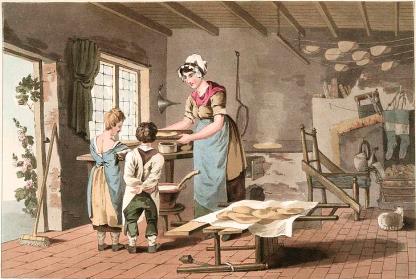

|
 (or Clapcake, Clap-Bread, Havver Bread) Large, flat oatmeal crispbread, cooked on a griddle, then dried out. Ivan Day's Clapcake From: https://www.historicfood.com/baking.htm  Yorkshire woman making oat havercakes Note the drying rack top right From: 'The Costume of Yorkshire', by George Walker (1781-1856) John Ray's A collection of English Words of 1691 includes Clap-Cake as a type of bannock "a thin hard oat-cake". The origin of the name is obscure, but Dickinson's 1878 Glossary of Cumberland Words suggests that "Clap bread, cakes beat and clapped out with the hands." while Henry Cunliffe's 1886 Glossary of Rochdale-with-Rossendale suggests that it was the clapping noise made when they were turned over to cook. The name is known at least since 'A Tour of the Westmorland Lakes' of 1697; "clap-breads are large thin oat-oaks, which were the chief diet of the people, and when well made, were as crisp and pleasant to eat as any thing you can imagine." We find more than 1000 references to havercakes or clapbread in newspapers from 1750 to 1900. In 1842 a writer in the 'Westmorland Gazette' on the 16th January 1819, discussing the virtues of free trade, could enthuse that "Commerce has had the effect of putting more porridge upon the plates, and more havercake upon the creel of those engaged in labor" Baines's Lancashire reports that a regiment of soldiers raised near Rochadle took the name of the "Havercake Lads," assuming as their badge an oat cake, which was placed (for the purpose of attracting recruits) on the point of the recruiting sergeant's sword. Recruiting soldiers with the promise of havercakes, c1815 Racks for drying-out clapcakes are still seen in old farmhouses etc, though the making of clapbread is now very rare. This is mentioned in Gaskell's 1863 novel 'Sylvia's Lovers'; "The great rack of clap-bread hung over-head." See; Broughton or Brough-Wham  Original Receipt from 'Lakeland Recipes Old and New' by Joan Poulson 1978. (Countryside Publications, ISBN 0 86157 008 1). Found by Linda Johnson Original Receipt from 'Lakeland Recipes Old and New' by Joan Poulson 1978. (Countryside Publications, ISBN 0 86157 008 1). Found by Linda Johnsonp38 No. 52 Havver Bread 6oz fine or medium oatmeal A pinch each of salt and bicarbonate of soda 2oz flour Boiling water One tablespoon melted dripping or butter Mix together the dry ingredients and add fat with enough boiling water to make a pliable dough. Knead well and roll out thinly. Cut into rounds or triangles and bake until brown and crisp, about 25 minutes at 350F, 180C or gas mark 4. Serve buttered with cheese or preserves.  |
|
MORE FROM Foods of England... Cookbooks ● Diary ● Index ● Magic Menu ● Random ● Really English? ● Timeline ● Donate ● English Service ● Food Map of England ● Lost Foods ● Accompaniments ● Biscuits ● Breads ● Cakes and Scones ● Cheeses ● Classic Meals ● Curry Dishes ● Dairy ● Drinks ● Egg Dishes ● Fish ● Fruit ● Fruits & Vegetables ● Game & Offal ● Meat & Meat Dishes ● Pastries and Pies ● Pot Meals ● Poultry ● Preserves & Jams ● Puddings & Sweets ● Sauces and Spicery ● Sausages ● Scones ● Soups ● Sweets and Toffee ● About ... ● Bookshop ● Email: [email protected] COPYRIGHT and ALL RIGHTS RESERVED: © Glyn Hughes 2022 BUILT WITH WHIMBERRY |